|
In the Days before the Deluge
I understand the enigmatic words in the stone carvings from the days
before the Deluge.
So had stated, in a self-laudatory inscription, the Assyrian king
Ashurbanipal. Indeed, throughout the diversified literature of ancient
Mesopotamia,
there were scattered references to a deluge that had swept over
Earth.
Could it then be, scholars wondered as they came upon such
references,
that the detailed biblical tale of the Deluge was not a myth or
allegory, but
the record of an actual event—an event remembered not by the Hebrews
lone?
Moreover, even the single sentence in Ashurbanipal's inscription was
full
of scientific dynamite. He not only confirmed that there had been a
Deluge;
he stated that his tutoring by the God of Scribes included the
understanding of pre-Diluvial inscriptions, "the enigmatic words in the stone
carvings
from the days before the Deluge." It could only mean that even
before the
Deluge there had been scribes and stone carvers, languages and
writing—
that there had been a civilization in the remote days before the
Deluge!
It was traumatic enough to have realized that the roots of our
modern
western civilization go back not to Greece and Judea of the first
millennium
B.C., and not to Assyria and Babylonia of the second millennium
B.C., and
not even Egypt of the third millennium B.C. —but to Sumer of the
fourth
millennium B.C. Now, scientific credibility had to be stretched even
farther
back, to what even the Sumerians considered "the olden days" —to an
enigmatic era "before the Deluge."
Yet, all these shocking revelations should have been old news to
anyone
who had cared to read the Old Testament's words for what they
actually
said: that after Earth and the Asteroid Belt (the Raki'a or Heaven
of
Genesis) had been created, and Earth had taken shape, and life
evolved,
and "the Adam" created—Man was placed in the Orchard that was in
Eden.
But through the machinations of a brilliant "Serpent" who dared call
the
bluff of God, Adam and his female companion Eve acquired certain
knowing which they were not supposed to possess. Thereupon, the
Lord— speaking to unnamed colleagues—grew concerned that Man,
"having become as one of us." might also help himself to the Tree of
Life, "and eat, and live forever."
So He drove out the Adam;
And he placed at the east of the Garden of
Eden
the Cherubim, and the Flaming Sword which revolveth,
to guard the
way to the Tree of Life.
Thus was Adam expelled from the wonderful orchard which the Lord had
planted in Eden, from then on to "eat the herbs of the field" and
obtain his sustenance "by the sweat of thy face." And
"Adam knew Eve
his wife and she conceived and bore Cain... and she bore again,
his brother, Abel; and Abel was a keeper of sheep, and Cain was a
tiller of the land."
The biblical claim of a pre-Diluvial civilization then proceeds
along two lines, beginning with the line of Cain. Having murdered
Abel—there is a hint of homosexuality as the cause—Cain was expelled
farther east, to the "Land of Migrations." There his wife bore him
Enoch—a name meaning "Foundation"; and the Bible explains that Cain
"was building a city" when Enoch was born, "so he named the city
Enoch,' as a namesake of his son Enoch." (The application of the
same name to a person and the city associated with him was a custom
that prevailed throughout the history of the ancient Near East.)
The line of Cain continued through Irad, Mechuyah-el, Metusha-el and
Lamech. The first son of Lamech was Jabal—a name which in the
original Hebrew (Yuval) means "The Lute Player." As the Book of
Genesis explains, "Jabal was the ancestor of all such as play the
harp and the lyre." A second son of Cain, Tubal-Cain, could "sharpen
all cutters of copper and iron." What became of these capable people
in the eastern Lands of Migration, we are no longer told; for the
Old Testament, considering the line of Cain to be accursed, lost all
interest in tracking further their genealogies and fate.
Instead, the Book of Genesis (in Chapter V) turns back to Adam and
to his third son Seth. Adam, we are told, was 130 years old when
Seth was born, and lived another 800 years for a total of 930 years.
Seth, who fathered Enosh at age 105, lived to be 912. Enosh begot
Cainan at age 90, and died at age 905. Cainan lived to the ripe age
of 910; his son Mahalal-el was 895 years old when he died; and his
son, Jared, passed on at age 962.
For all these pre-Diluvial patriarchs, the Book of Genesis provides
the bare biographical information: who was their father, when their
male heir was born, and (after "giving birth to other sons and
daughters") when they died. But when the next patriarch is listed,
he gets special treatment:
And Jared lived a hundred and
sixty-two years, and begot Enoch...
And Enoch lived sixty-five years, and begot Methuselah.
And Enoch walked with the Lord, after he had begotten Methusaleh,
for three hundred years; and he begot (other) sons and daughters.
And all the days of Enoch were three hundred and sixty and five
years.
And here comes the explanation—an astounding explanation—of why
Enoch was singled out for so much attention and biographical detail:
Enoch did not die!
For Enoch had walked with the Lord, and was gone; for the Lord had
taken him away.
Methusaleh lived the longest—969 years—and was succeeded by Lamech.
Lantech (who lived to be 777 years) begot Noah—the hero of the
Deluge. Here too there is a brief biographical-historical note:
Lamech had so named his son, we are informed, because Mankind was
undergoing at that time great sufferings, and the earth was barren
and unproductive. In naming his son Noah ("Respite"), Lamech
expressed the hope that
"This one shall bring us respite of our toil
and frustrations of the land which the Lord had cursed."
And so, through ten generations of pre-Diluvial patriarchs blessed
with what scholars call "legendary" life spans, the biblical
narrative reaches the momentous events of the Deluge.
The Deluge is presented in the Book of Genesis as the opportunity
seized by the Lord "to destroy the Man whom I had created from the
face of the Earth." The ancient authors found it necessary to
provide an explanation for such a far-reaching decision. It had to
do, we are told, with Man's sexual perversions; specifically, with
the sexual relations between "the daughters of Man" and "the sons of
the Gods."
In spite of the monotheistic endeavors of the compilers and editors
of the Book of Genesis, struggling to proclaim faith in a sole deity
in a world that in those days believed in many Gods, there remain
numerous slip-ups where the biblical narrative speaks of Gods in the
plural. The very term for "deity," (when the Lord is not
specifically named as Yahweh), is not the singular El but the plural
Elohim. When the idea of creating Adam occurs, the narrative adopts
the plural language:
"
And Elohim (= the deities) said: 'Let us make
Man in our image and after our Likeness."
And when the incident
with the Fruit of Knowing had occurred, Elohim again spoke in the
plural to unnamed colleagues.
Now, it transpires from four enigmatic verses of Genesis VI that set
the stage for the Deluge, that not only were there deities in the
plural, but that they even had sons (in the plural). These sons
upset the Lord by having sex with the daughters of Man, compounding
their sins by having children or demi-Gods born from this illicit
lovemaking.
And it came to pass When the Earthlings began to multiply upon the
Earth, and daughters were born unto them—
That the sons of the Gods saw the daughters of Adam, that they were
good; And they took them for wives, of all which they chose.
And the Oletusmake.swffex770,325further:
The Nefilim were upon the Earth in those days and thereafter too;
Those sons of the Gods who cohabited with the daughters of the Adam,
and they bore children unto them.
They were the Mighty Ones of Eternity, the People of the Shetn.
Nefilim—traditionally translated "giants"—literally means "Those Who
Were Cast Upon" the earth. They were the "Sons of the Gods"—"the
people of the Shem," the People of the Rocketships.
We are back to Sumer and the DIN.GIR, the "Righteous Ones of the
Rocket Ships." Let us then pick up the Sumerian record where we left
off—450,000 years ago.
It was some 450,000 years ago, the Sumerian texts claim, that
astronauts from Marduk came to Earth in search of gold. Not for
jewelry, but for some pressing need affecting survival on
the
Twelfth Planet.
The first landing party numbered fifty astronauts; they were called
Anunnaki—"Those of Heaven Who Are on Earth." They splashed down in
the Arabian Sea, and made their way to the head of the Persian Gulf,
establishing there their first Earth Station E.RI.DU—"Home in
Faraway Built." Their commander was a brilliant scientist and
engineer who loved to sail the seas, whose hobby was fishing. He was
called E.A—"He Whose House Is Water," and was depicted as the
prototype Aquarius; but having led the landing on Earth, he was
given the title EN.KI—"Lord Earth." Like all the Sumerian Gods, his
distinguishing feature was the horned headdress (Fig. 51).
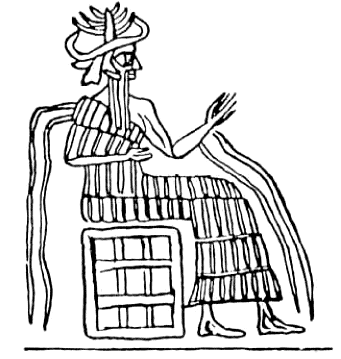
Fig.51
The original plan, it appears, was to extract the gold from the
seawaters; but the plan proved unsatisfactory. The only alternative
was to do it the hard way: to mine ores in southeastern Africa, haul
them by ship to Mesopotamia, and there smelt and refine them. The
refined gold ingots were then sent aloft in Shuttlecraft, to an
Earth-orbiting craft. There they awaited the periodic arrival of the
Mother Spaceship, which took the precious metal back home.
To make this possible, more Anunnaki were landed on Earth, until
their number reached 600; another 300 serviced the Shuttlecraft and
orbiting station. A Spaceport was built at Sippar ("Bird Town") in
Mesopotamia, on a site aligned with the Near East's most conspicuous
landmark—the peaks of Ararat. Other settlements with various
functions—such as the smelting and refining center of Bad-Tibira, a
medical center named Shuruppak—
were laid out to form an arrow-like Landing Corridor. In the exact
center, NIBRU.KI—"The Crossing Place on Earth" (Nippur in
Akkadian)—was established as the Mission Control Center.
The commander of this expanded enterprise on Planet Earth was
EN.LIL—"Lord of the Command." In the early Sumerian pictographic
writing, Enid's name and his Mission Control Center were depicted as
a complex of structures with tall antennas and wide radar screens
(Fig. 52).

Fig. 52
Both Ea/Enki and Enlil were sons of the then ruler on the Twelfth
Planet, AN (Akkadian Anu), whose name meant "He of the Heavens" and
was written pictographically as a star
 Ea was the firstborn; but
because Enlil was born to Anu by another wife who was also his
half-sister, Enlil and not Ea was the heir to the throne. Now Enlil
was sent to Earth, and took over the command from Ea, the so-called
Lord Earth. Ea was the firstborn; but
because Enlil was born to Anu by another wife who was also his
half-sister, Enlil and not Ea was the heir to the throne. Now Enlil
was sent to Earth, and took over the command from Ea, the so-called
Lord Earth.
Matters were further complicated by the
dispatch to
Earth as Chief Medical Officer of NIN.HUR.SAG ("Lady of the
Mountainpeak"), a half-sister of both Ea and Enlil—enticing both
brothers to seek her favors; for by the same rules of succession, a
son to one of them by her would inherit the throne. The lingering
resentment on Ea's part, compounded by the growing competi-tion
between the brothers, eventually spilled off to their offspring and
was the underlying cause of many events that followed.
As the millennia passed on Earth —though to the Anunnaki each 3,600
years were but one year of their own life cycles —these
rank-and-file astronauts began to grumble and complain. Was it
indeed their task as spacemen to dig for ores deep inside dark,
dusty, hot mines? Ea—perhaps to avoid friction with his
brother—spent more and more time in south-eastern Africa, away from
Mesopotamia. The Anunnaki who toiled in the mines addressed their
complaints to him; together they talked over their mutual
dissatisfactions.
Then, one day, as Enlil arrived in the mining area for a tour of
inspection, the signal was given. A mutiny was declared. The
Anunnaki left the mines, put their tools on fire, marched on Enlil's
residence and encircled it, shouting: "No more!"
Enlil contacted Anu and offered to resign his command and return to
the home planet. Anu came down to Earth. A court-martial was held.
Enlil demanded that the instigator of the mutiny be put to death.
The Anunnaki, all as one, refused to divulge his identity. Hearing
the evidence, Anu concluded that the work was indeed too harsh. Was
the gold mining then to be discontinued?
Ea then offered a solution. In southeastern Africa, he said, there
roamed a being that could be trained to perform some of the mining
tasks—if only the "mark of the Anunnaki" could be implanted upon it.
He was talking of the Apemen and Apewomen, who had evolved on
Earth—but were still far behind the evolutionary level attained by
the inhabitants of the Twelfth Planet. After much deliberation, Ea
was given the go-ahead: "Create a Lulu," a "primitive worker," he
was told; "let him bear the yoke of the Anunnaki."
Ninhursag, the chief medical officer, was to assist him. There was
much trial and error until the right procedure was perfected.
Extracting the egg of Apewoman, Ea and Ninhursag fertilized it with
the sperm of a young astronaut. Then they reimplanted the fertilized
egg not in the womb of the Apewoman, but in the womb of a female
astronaut. Finally, the "Perfect Model" was achieved, and Ninhursag
shouted with joy. "I have created— my hands have made it!" She held
up for all to see the first Homo sapiens (Fig. 53)—the Earth's
first-ever test-tube baby.
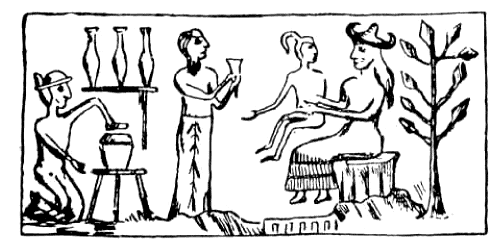
Fig, 53
But like any hybrid, the Earthling could not procreate on his own.
To obtain more primitive workers, Apewomen eggs were extracted,
fertilized, and reimplanted in the wombs of "birth
Goddesses"—fourteen at a time: seven to be born males, seven
females. As the Earthlings began to take over mining work in
southeastern Africa, the Anunnaki who toiled in Mesopotamia grew
jealous: they too clamored for primitive workers. Over the
objections of Ea, forcibly, Enlil seized some of the Earthlings and
brought them to the E.DIN—the "Abode Of The Righteous Ones" in
Mesopotamia. The event is recalled in the Bible.
"And the Lord took
the Adam, and He placed him in the garden in Eden, to till it and
tend it."
All along, the astronauts who had come to Earth were preoccupied
with the problem of longevity. Their biological clocks were set for
their own planet: the time it took their planet to orbit the Sun
once was to them but a single year of their life spans. But in such
a single year, Earth orbited the Sun 3,600 times—a span of 3,600
years for Earth-originated life. To maintain their longer cycles on
the quick-paced Earth, the astronauts consumed a "Food of Life" and
"Water of Life" which were provided from the home planet. At his
biological laboratories in Eridu, whose emblem was the sign of the
Entwined Serpents (Fig. 54), Ea tried to unravel the secrets of
life, reproduction, death.
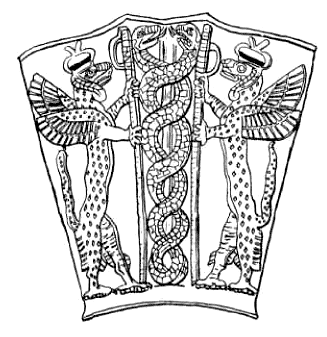
Fig. 54
Why did the children born to the
astronauts on Earth age so much faster than their parents? Why did Apemen live such short lives? Why did the hybrid Homo sapiens live
much longer than Apeman, but only brief lives compared to the
visitors to Earth? Was it environment, or inherent genetic traits?
Conducting further experiments in genetic manipulation on the
hybrids, and using his own sperm, Ea came up with a new "perfect
model" of Earthling. Adapa, as Ea had named him, had greater
intelligence; he acquired the all-important ability to procreate,
but not the longevity of the astronauts;
With wide understanding
he
had perfected him...
To him he had given Knowing;
Lasting Life
him he did not give.
Thus were Adam and Eve of the Book of Genesis given the gift or
fruit not only of Knowledge but also of Knowing—the biblical Hebrew
term for intercourse for the purpose of having offspring. We find
this "biblical" tale illustrated in an archaic Sumerian drawing
(Fig. 55).
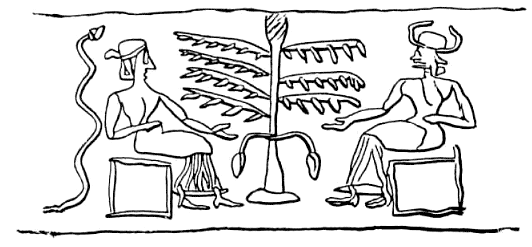
Fig. 55
Enlil was outraged on discovering what Ea had done. It was never
intended that Man should be able to procreate like the Gods. What
next, he asked—would Ea also achieve for Man an everlasting life
span? On the home planet, Anu too was perturbed.
"Rising from his
throne, he ordered: 'Let them fetch Adapa hither!'"
Afraid that his perfected human would be destroyed at the Celestial
Abode, Ea instructed him to avoid the food and water that would be
offered to him, for they would contain poison;
"He gave him this
advice:
Adapa,
Thou art going before Anu, the Ruler.
The road to Heaven wilt
thou take.
When to Heaven thou hast gone up,
and hast approached the gate of Anu,
Tammuz and Gizzida at the gate
will be standing...
They will speak to Anu;
Anus benign face they
will cause to be shown thee.
As thou standest before Anu,
When they
offer thee the Bread of Death,
thou shalt not eat it.
When they offer thee the Water of Death,
thou
shalt not drink it...
"Then he made him take the road to Heaven, and to Heaven he went
up."
When Anu saw Adapa, he was impressed by his intelligence and
the extent to which he had learned from Ea "the plan of Heaven and
Earth." "What shall we do about him," he asked his counselors, now
that Ea "distinguished him by making a Shem for him"—by letting
Adapa travel in a spacecraft from Earth to Marduk?
The decision was to keep Adapa permanently on Marduk. So that he
could survive, "the Bread of Life they brought him," and the Water
of Life too. But forewarned by Ea, Adapa refused to eat or drink.
When his erroneous reasons were discovered, it was too late; his
chance to obtain everlasting life was missed.
Adapa was returned to Earth—a trip during which Adapa saw the
"awesomeness" of space, "from the horizon of Heaven to the zenith of
Heaven." He was ordained as the High Priest of Eridu; he was
promised by Anu that henceforth the Goddess of Healing would also
attend to the ailments of Mankind. But Mortal's ultimate
goal—everlasting life—was no longer his.
From then on, Mankind proliferated. The humans were no longer just
slaves in the mines or serfs in the fields. They performed all
tasks, built "houses" for the Gods—we call them "temples"—and
quickly learned how to cook, dance and play music for them. It was
not long before the young Anunnaki, short of female company of their
own, took to having sex with the daughters of Man. Since they were
all of the same first Seed of Life, and Man was a hybrid created
with the genetic "essence" of the Anunnaki, the male astronauts and
the female Earthlings discovered that they were biologically
compatible; "and children were born unto them."
Enlil viewed these developments with rising apprehension. The
original purpose of coming to Earth, the sense of mission, the
dedication to the task—were dissipated and gone. The good life
seemed to be the main concern of the Anunnaki—and with a race of
hybrids to boot!
Nature, as it were, offered Enlil a chance to put a halt to the
deteriorating mores and ethics of the Anunnaki. Earth was entering a
new ice age, and the pleasant climate was changing. As it got
colder, it also became dryer. Rains became less frequent, the river
waters sparser. Crops failed, famine spread. Mankind began to
undergo great sufferings; daughters hid food from their mothers,
mothers ate their young. At the urging of Enlil, the Gods refrained
from helping Mankind: Let them starve, let them be decimated, Enlil
decreed.
In the "Great Below"—in Antarctica—the Ice Age was also causing
changes. From year to year, the ice cap covering the continent at
the South Pole grew thicker and thicker. Under the increasing
pressure of its weight, friction and heat increased at its bottom.
Soon the immense ice cap was floating on a slippery slush of mud.
From the orbiting shuttlecraft, an alarm was sounded: the ice cap
was becoming unstable; if it should happen to slip off the continent
into the ocean—an immense tidal wave would engulf all of Earth!
It was not an idle danger. In the heavens, the Twelfth Planet was
orbiting back to the Place of Crossing between Jupiter and Mars. As
on previous occasions when it neared Earth, its gravitational pull
caused earthquakes and other disturbances upon Earth and in its
celestial motions. Now, it was calculated, this gravitational pull
could well trigger the slippage of the ice cap, and inundate Earth
with a global deluge. From this catastrophe, the astronauts
themselves could not be immune.
As preparations were made to assemble all the Anunnaki near the
Spaceport, and ready the craft to take them aloft before the tidal
wave struck, ruses were employed to keep the approaching catastrophe
a secret from Mankind. Fearing that the Spaceport would be mobbed,
all the Gods were made to swear to secrecy. And as to Mankind, Enlil
said—Let them perish; let the seed of Earthling be wiped off the
face of Earth.
In Shuruppak, the city under the lordship of Ninhursag, relations
between Man and Gods had gone the farthest. There, for the first
time ever, a man was elevated to the status of king. As the
sufferings of Mankind increased, ZI.U.SUD.RA (as the Sumerians
called him) pleaded for the help of Ea. From time to time, Ea and
his seafarers clandestinely brought Ziusudra and his people a load
of fish. But now the question involved the very destiny of Mankind.
Shall all the handiwork of Ea and Ninhursag perish "and turn to
clay" as Enlil wished—or should the Seed of Mankind be preserved?
Acting on his own, but mindful of his oath, Ea saw in Ziusudra the
chance to save Mankind. The next time Ziusudra came to pray and
plead in the temple, Ea began to whisper from behind a screen.
Pretending to talk to himself, Ea gave Ziusudra urgent instructions:
Tear down the house, build a ship!
Give up possessions, seek thou life!
Foreswear belongings, keep soul alive!
Aboard ship take thou the seed of all living things.
That ship thou shalt build;
Her dimensions shall be to measure.
The ship was to be a submersible vessel, a "submarine" that could
withstand the avalanche of water. The Sumerian texts contain the
dimensions and other structural instructions for the various decks
and compartments in such detail that it is possible to draw the
ship, as was done by Paul Haupt (Fig. 56). Ea also provided
Ziusudra
with a navigator, instructing him to direct the vessel toward the
"Mount of Salvation," Mount Ararat; as the highest range in the Near
East, its peaks would be the first to emerge from under the waters.
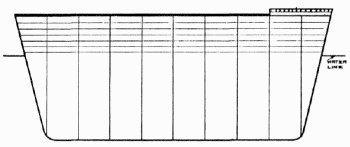
Fig. 56
The Deluge came as expected. "Gathering speed as it blew" from the
south, "submerging the mountains, overtaking the people like a
battle." Viewing the catastrophe from above, as they orbited Earth
in their craft, the Anunnaki and their leaders realized how much
they had fallen in love
with Earth and with Mankind.
"Ninhursag wept... the Gods wept
with her for the land.... The Anunnaki, all humbled, sit and
weep" as they huddled, cold and hungry, in their Shuttlecraft.
When the waters subsided and the Anunnaki began to land on Ararat,
they were elated to discover that the Seed of Mankind was saved. But
as Enlil too arrived, he was furious to see that "a living soul had
escaped." It took the pleadings of the Anunnaki and the persuasion
of Ea, to bring him around to their point of view—that if Earth was
to be resettled, the services of Man were indispensable.
And so it was, that the sons of Ziusudra and their families were
sent out to settle the mountain ranges flanking the plain of the two
rivers, to await the time when the plain was dry enough to inhabit.
As to Ziusudra, the Anunnaki,
Life like that of a God they gave him;
Breath eternal, like a God,
they granted him.
This they achieved by exchanging his "Breath of Earth" with the
"Breath of Heaven." Then they took Ziusudra, "the preserver of the
seed of Mankind," and his wife, to "reside in the faraway place"—
In the Land of the Crossing,
The Land Tilmun,
The place where Utu
rises,
They caused him to dwell.
It is evident by now that the Sumerian tales of the Gods of Heaven
and Earth, of the Creation of Man and of the Deluge, were the
fountainhead from which the other nations of the ancient Near East
drew their knowledge, beliefs and "myths." We have seen how the
Egyptian beliefs matched the Sumerian ones, how their first sacred
city was named after An, how the Ben-Ben resembled the Sumerian GIR,
and so on.
It is also generally accepted by now, that the biblical tales of the
Creation and of the events leading to the Deluge are condensed
Hebrew versions of the Sumerian traditions. The biblical hero of the
Deluge, Noah, was the equivalent of the Sumerian Ziusudra (who was
called Utnapishtim in the Akkadian versions).
But while the
Sumerians asserted that the hero of the Deluge was made immortal, no
such claim is made in the Bible for Noah. The immortalization of
Enoch is also given short shrift, quite unlike the detailed
Sumerian
tale of Adapa or other texts dealing with other Ascents. But this
abrupt biblical attitude could not prevent the spread, over the
millennia, of legends dealing with the biblical heroes and their
sojourn in, or return to, Paradise.
According to very ancient legends, which survived in a number of
versions stemming from a composition almost 2,000 years old called
The Book of Adam and Eve, Adam fell sick after he was 930 years old.
Seeing his father "sick and in pain," his son Seth volunteered to go
to "the nearest gate of Paradise... and lament and make entreaty
to God; perchance He will hearken to me and send His angel to bring
me the fruit, for which thou hast longed"—the fruit of the Tree of
Life.
But Adam, accepting his mortal's fate, only wished for the
excruciating pains to be relieved. So he asked Eve his wife to take
Seth, and together go "to the neighborhood of Paradise"; there to
ask not for the Fruit of Life, but only for one drop of the "oil of
life" which floweth from the Tree, "to anoint me with it, that I may
have rest from these pains."
Having done as Adam asked, Eve and Seth reached the gates of
Paradise, and entreated with the Lord. Finally, the angel Michael
appeared unto them—only to announce that their request would not be
granted. "The time of Adam's life is fulfilled," the angel said; his
death was not to be averted or postponed. Six days later, Adam died.
Even the historians of Alexander created a direct link between his
miraculous adventures and Adam, the very first man who had dwelt in
Paradise, and was proof of its existence and lifegiving powers. The
connecting link in the case of Alexander was the unique stone which
emitted light: it was said to have been brought out of the Garden of
Eden by Adam, then handed down from generation to generation, until
it reached the hands of an immortal Pharaoh, who in turn gave it to
Alexander.
The plot-of-parallels indeed thickens, as one realizes that there
exists an old Jewish legend, whereby the staff with which Moses
performed many miracles, including the parting of the waters of the
Lake of Reeds, was brought out of the Garden of Eden by Adam. Adam
gave it to Enoch; Enoch gave it to his great-grandson Noah, the hero
of the Deluge. Then it was handed down through the line of Shem, son
of Noah, from generation to generation, until it reached Abraham
(the first Hebrew patriarch).
Abraham's great-grandson Joseph
brought it with him to Egypt, where he rose to highest rank in the
Pharaoh's court. There the staff remained among
the treasures of the Egyptian kings; and thus it reached the hands
of Moses, who was raised as an Egyptian prince before he escaped
into the Sinai peninsula. In one version, the staff was carved out
of a single stone; in another, it was made of a branch of the Tree
of Life, which grew in the Garden of Eden.
In these interwoven relationships, harkening back to the earliest
times, there were also tales linking Moses with Enoch, A Jewish
legend, called "The Ascent of Moses," relates that when the Lord
summoned Moses at Mount Sinai and charged him to lead the Israelites
out of Egypt, Moses resisted the mission for various reasons,
including his slow and non-eloquent speech.
Determined to remove his
meekness, the Lord decided to show him His throne and "the angels of
the Heavens" and the mysteries thereof.
So "God commanded Metatron,
the Angel of the Countenance, to conduct Moses to the celestial
regions." Terrified, Moses asked Metatron: "Who art thou?"
And the
angel (literally: "emissary") of the Lord replied: "I am Enoch, son
of Jared, thy ancestor." (Accompanied by the angelic Enoch, Moses
soared through the Seven Heavens, and saw Hell and Paradise; then he
was returned to Mount Sinai, and accepted his mission.)
Further light on the occurrences concerning Enoch, and his
preoccupation with the impending Deluge and its hero, his
great-grandson Noah, is shed by yet another ancient book, the Book
of Jubilees. It was also known in early times as the Apocalypse of
Moses, for it allegedly was written down by Moses at Mount Sinai as
an angel dictated to him the histories of days past. (Scholars,
though, believe that the work was composed in the second century
B.C.)
It follows closely the biblical narratives of the Book of Genesis;
yet it provides more detail, such as the names of wives and
daughters of the pre-Diluvial patriarchs. It also enlarges upon the
events experienced by Mankind in those prehistoric days. The Bible
informs us that the father of Enoch was Jared ("Descent"), but not
why he was so named. The Book of Jubilees provides the missing
information. It says that the parents of Jared so named him,
For in his days the angels of the Lord descended upon Earth—those
who
are named The Watchers—that they should instruct the children of
men,
that they should do judgment and uprightness upon Earth.
Dividing the eras into "jubilees," the Book of Jubilees further
narrates that,
"in the eleventh jubilee Jared took to himself a wife;
her name was Baraka ("Lightning Bright"), the daughter of Basujal, a
daughter of his father's brother... and she bare him a son and he
called his name Enoch. And he (Enoch) was the first among men that
are born on Earth who learnt writing and knowledge and wisdom, and
who wrote down the signs of heaven according to the order of their
months in a book, that men might
know the seasons of the year according to the order of their
separate months.''
In the twelfth jubilee. Enoch took as wife Edni ("My Eden"), the
daughter of Dan-el. She bare him a son whose name was Methuselah.
After that. Enoch
"was with the angels of God for six jubilees of
years, and they showed him everything which is on Earth and in the
Heavens... and he wrote down everything."
But by then, trouble was brewing. The Book of Genesis reports that
it was before the Deluge,
"That the sons of the Gods saw the
daughters of Man, that they were good, and they took them for wives
of all which they chose... and it repented the Lord that He had
made Man on Earth... and the Lord said: I will destroy the Man
whom I had created from the face of the Earth."
According to the Book of Jubilees,
Enoch played some role in this
changed attitude by the Lord, for "he testified about the Watchers
who had sinned with the daughters of men; he testified against them
all." And it was to protect him from the revenge of the sinning
Angels of the Lord, that "he was taken from amongst the children of
men, and was conducted into the Garden of Eden." Specifically named
as one of the four places of God on Earth, it was in the Garden of
Eden that Enoch was hidden, and where he wrote down his Testament.
It was after that that Noah, the righteous man singled out to
survive the Deluge, was born. His birth, occurring at the troubled
times when the "sons of the Gods" were indulging in sex with mortal
females, caused a marital crisis in the patriarchal family. As the
Book of Enoch tells it, Methuselah "took a wife for his son Lamech,
and she became pregnant by him and bore a son."
But when the
baby—Noah—was born, things were not as usual:
His body was white as snow and red as the blooming of a rose, and
the
hair of his head and his long locks were white as wool, and his eyes
were
beautiful.
And when he opened his eyes, he lighted up the whole house like the
sun, and the whole house was very bright.
And thereupon he arose in the hands of the midwife, opened his
mouth, and conversed with the Lord of Righteousness.
Shocked, Lamech ran to his father Methuselah, and said:
I have begotten a strange son, diverse from and unlike Man, and
resembling the sons of the God of Heaven; and his nature is
different,
and he is not like us...
And it seems to me that he is not sprung from me but from the
angels.
Suspecting, in other words, that his wife's pregnancy was induced
not by him, but that she was impregnated by one of the angels,
Lamech had an idea: Since his grandfather Enoch was staying amongst
the Sons of the Gods, why not ask him to get to the bottom of this?
"And now, my father," he said to Methuselah. "I petition thee and
implore thee that thou mayest go to Enoch thy father, and learn from
him the truth, for his dwelling place is amongst the angels."
Methuselah went as Lamech had asked, and reaching the Divine Abode
summoned Enoch, and reported the unusual baby boy. Making some
inquiries, Enoch assured Methuselah that Noah was indeed a true son
of Lamech; and that his unusual countenance was a sign of things to
come: "There shall be a Deluge and great destruction for one year,"
and only this son, who is to be named Noah ("Respite") and his
family shall be saved. These future things, Enoch told his son, "I
have read in the heavenly tablets."
The term employed in these ancient, even if ex-biblical scriptures,
to denote the "sons of the Gods" involved in the pre-Diluvial
shenanigans, is "Watchers." It is the very term Neter ("Watchers")
by which the Egyptians called the Gods, and the exact meaning of the
name Shumer, their landing place on Earth.
The various ancient books which throw this extra light on the
dramatic events in the days before the Deluge, have been preserved
in several versions that are all only translations (direct and
indirect) of lost Hebrew originals. Yet their authenticity was
confirmed with the renowned discoveries in recent decades of the
Dead Sea Scrolls, for among the finds were fragments of scrolls
which were undoubtedly parts of the Hebrew originals of such
"memoirs of the Patriarchs."
Of particular interest to us is a scroll fragment which deals with
the unusual birth of Noah, and from which we can learn the original
Hebrew term for what has been translated as "Watchers" or "Giants,"
not only in the ancient versions, but even by modern scholars (as T.
H. Gaster, The Dead Sea Scriptures and H. Dupont-Sommer,
The Essene
Writings from Qumran).
According to these scholars, column II of the
scroll fragment begins thus:
Behold, I thought in my heart that the conception was from one of
the
Watchers, one of the Holy Ones, and (that the child really belonged)
to
the Giants.
And my heart was changed within me because of the child.
Then I, Lamech, hastened and went to Bath-Enosh (my) wife, and I
said to Her:
[I want you to take an oath] by the Most High, by the Lord Supreme,
the King of all the worlds,
the ruler of the Sons of Heaven, that you will tell me in truth
whether...
But as we examine the Hebrew original (Fig. 57) we find that it does
not say "Watchers"; it says Nefilim—the very term used in Genesis 6.
Thus do all the ancient texts and all the ancient tales confirm each
other: The days before the Deluge were the days when,
"The Nefilim
were upon the Earth—the Mighty Ones, the People of the Rocketships."
Column II

Fig. 57
In the words of the
Sumerian King Lists, "the Deluge has swept over"
120 shars—120 orbits of 3,600 years each—after the first landing on
Earth. This places the Deluge at about 13,000 years ago. It is
exactly the time when the last ice age ended abruptly, when
agriculture began. It was followed 3,600 years later by the New
Stone Age (as scholars call it), the age of pottery. Then, 3,600
years later, Civilization all at once blossomed out—in the "plain
between the rivers," in Shumer.
"And the whole Earth was of one language and of one kind of things,"
the Book of Genesis says; but soon after the people had established
themselves in the Land of Shin'ar (Sumer), and built dwellings of
fired clay bricks, they conspired to "build a city, and a Tower the
top of which can reach unto Heaven."
The Sumerian texts from which this biblical tale was extracted have
not yet been found; but we do come across allusions to the event in
various Sumerian tales. What emerges is an apparent effort on the
part of Ea to enlist Mankind in gaining control over the space
facilities of the Nefilim— one more incident in the continuing feud
between Ea and Enlil, which by then had spilled over to their
offspring. As a result of the incident, the Bible tells us, the Lord
and his unnamed colleagues decided to disperse Mankind and "confuse"
its languages—give it diverse and separate civilizations.
The deliberations of the Gods in the era following the Deluge are
mentioned in various Sumerian texts. The one called the
Epic of Etana states:
The Great Anunnaki who decree the fate sat exchanging their counsels
regarding the Earth. They who created the four regions, who set up
the settlements, who oversaw the land, were too lofty for Mankind.
The decision to establish on Earth four Regions was thus coupled
with a decision to install intermediaries (priest-kings) between the
Gods and Mankind; so "kingship was again lowered to Earth from
Heaven."
In an effort—which proved futile—to end or abate the feud between
the Enlil and Ea families, lots were drawn between the Gods to
determine who would have dominion over which of the Regions. As a
result, Asia and Europe were assigned to Enlil and his offspring; to
Ea, Africa was given.
The First Region of civilization was Mesopotamia and the lands
bordering upon it. The mountain-lands where agriculture and settled
life began, the lands that came to be known as Elam, Persia,
Assyria—were given to Enlil's son NIN.UR.TA, his rightful heir and
"Foremost Warrior." Some Sumerian texts have been found dealing with
Ninurta's heroic efforts to dam the mountain passes and assure the
survival of his human subjects in the harsh times that had followed
the Deluge.
When the layers of mud that had covered the Plain between the Two
Rivers dried up sufficiently to permit resettlement, Shumer and the
lands that stretched therefrom westward to the Mediterranean were
put under the charge of Enlil's son NAN.NAR (Sin in Akkadian). A
benevolent God, he supervised the reconstruction of Sumer,
rebuilding pre-Diluvial cities at their original sites and
establishing new cities.
Among the latter was his favorite capital
Ur, the birthplace of Abraham. His depictions included the crescent
symbol of the Moon, which was his celestial "counterpart" (Fig. 58).
To Enlil's youngest son, ISH.KUR (whom the Akkadians called
Adad),
were given the northwestern lands, Asia Minor and the Mediterranean
islands from where civilization—"Kingship"—eventually spread to
Greece. Like Zeus in later Greece, Adad was depicted riding a bull
and holding a forked lightning.
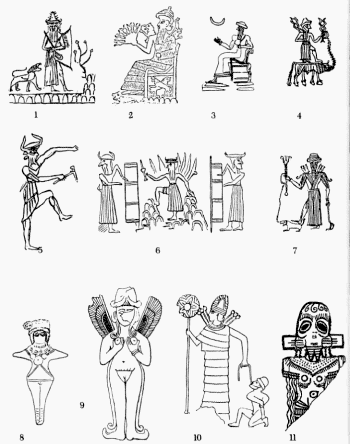
Fig. 58
THE GodS OF HEAVEN AND EARTH
1. ENLIL 2. NINURTA 3. NANNAR/Sin 4. ISHKUR/Adad 5. NERGAL 6. GIBIL
7. MARDUK
IRNINI/Ishtar as Great Lady (8), Enchantress (9), Warrior
(10), Pilot (11)
Ea too divided the Second Region, Africa, among his sons. It is
known that a son named NER.GAL lorded over the southernmost parts of
Africa. A son named GI.BIL learned from his father the arts of
mining and metallurgy, and took over control of the African gold
mines. A third son— Ea's favorite—was named by him after the home
planet MARDUK, and was taught by Ea all knowledge of sciences and
astronomy. (Circa 2000 B.C., Marduk usurped the Lordship of Earth
and was declared Supreme God of Babylon and of "the Four Quarters of
the Earth.") And, as we have seen, a son whose Egyptian name was Ra
presided over the core civilization of this Region, the civilization
of the Nile Valley.
The Third Region, as was discovered only some fifty years ago, was
in the subcontinent of India. There too, a great civilization arose
in antiquity, some 1,000 years after the Sumerian one. It is called
the Indus Valley Civilization, and its center was a royal city unearthed at a
site called Harappa. Its people paid homage not to a God but to a
Goddess, depicting her in clay figurines as an enticing female,
adorned with necklaces, her breasts enhanced by straps which crossed
her body.
Because the script of the Indus Civilization is still undeciphered,
no one knows what the Harappans called their Goddess, or who exactly
she was. It is our conclusion, however, that she was the daughter of
Sin, whom the Sumerians called IR.NI.NI ("The Strong, Sweetsmelling
Lady") and the Akkadians called Ishtar. Sumerian texts tell of her
dominion in a far land named Aratta—a land of grain crops and
granaries as Harappa was— whereto she made flying trips, attired as
a pilot.
It was in need of a Spaceport that the Fourth Region was set aside
by the Great Anunnaki—a Region not for Mankind, but for their own
exclusive use. All their space facilities from the time they had
landed on Earth—the Spaceport at Sippar, the Mission Control Center
at Mippur—were wiped out by the Deluge. The low-lying Mesopotamian
plain was still too muddy for millennia to enable the rebuilding
there of these vital installations. Another place —more elevated yet
suitable, secluded but accessible —had to be found for the Spaceport
and its auxiliary installations. It was to be a "sacred zone"—a
restricted area, accessible only by permission. It was called in
Sumerian TIL.MUN—literally, "Land of the Missiles."
In charge of this post-Diluvial Spaceport they put the son of Sin
(and thus a grandson of Enlil), a twin brother of Irnini/Ishtar. His
name was UTU ("The Bright One")—Shamash in Akkadian. It was he who
ably carried out Operation Deluge—the evacuation out of Sippar. He
was the chief of the Spacemen based on Earth, the "Eagles"; and he
proudly wore his Eagle-uniform on formal occasions (Fig. 59).
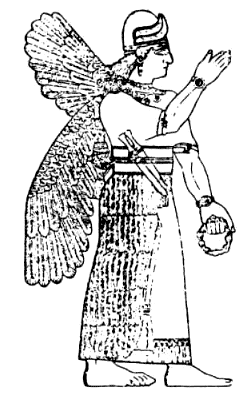
Fig. 59
In the days before the Deluge, traditions held, a few chosen mortals
had been taken aloft from the Spaceport:
-
Adapa, who missed his
chance
-
Enmeduranki, whom the Gods Shamash and Adad transported
to the Celestial Abode, to be initiated in priestly secrets (and
then returned to Earth)
-
Then there was Ziusudra ("His Life-Days
Prolonged"), hero of the Deluge, who was taken with his wife to live
in Tilmun
In post-Diluvial times, Sumerian records stated,
-
Etana—an early
ruler of Kish—was taken aloft in a Shem to the Abode of the Gods,
there to be granted the Plant of Rejuvenation and Birthgiving (but
he was too frightened to complete the journey)
-
Pharaoh Thothmes III claimed in his inscriptions that the
God Ra had taken
him aloft, given him a tour of the heavens, and returned him to
Earth:
-
He opened for me the doors of Heaven,
He spread open for me the
portals of its horizon.
I flew up to the sky as a divine Falcon...
That I might see his mysterious ways in heaven...
I was made full
with the understanding of the Gods.
In the later memories of Mankind, the Shem was cherished as an
obelisk, and the rocketship saluted by "Eagles" gave way to a sacred
Tree of Life (Fig. 60). But in Sumer, where the Gods were a present
reality—as in Egypt when the first Pharaohs had reigned—Tilmun, the
"Land of the Missiles," was a real place: a place where Man could
find Immortality.
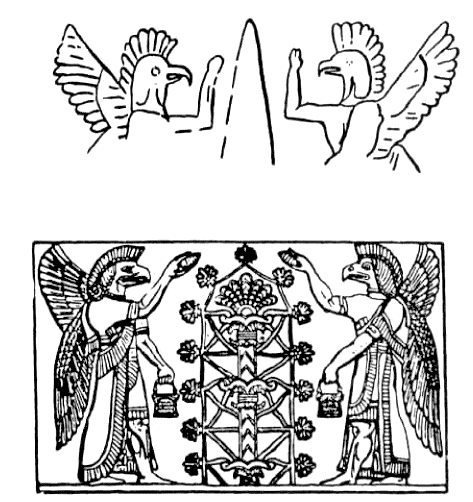
Fig. 60
And there, in Sumer, they recorded the tale of a man who—uninvited
by the Gods—set out to reverse his fate nevertheless.
Back to Contents
|


 Ea was the firstborn; but
because Enlil was born to Anu by another wife who was also his
half-sister, Enlil and not Ea was the heir to the throne. Now Enlil
was sent to Earth, and took over the command from Ea, the so-called
Lord Earth.
Ea was the firstborn; but
because Enlil was born to Anu by another wife who was also his
half-sister, Enlil and not Ea was the heir to the throne. Now Enlil
was sent to Earth, and took over the command from Ea, the so-called
Lord Earth. 






